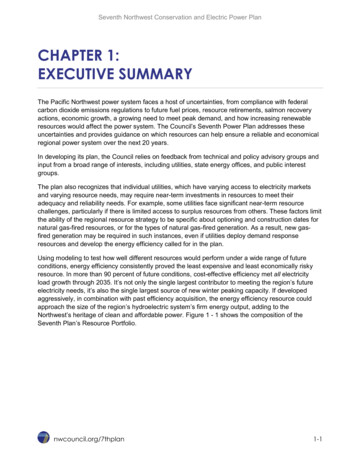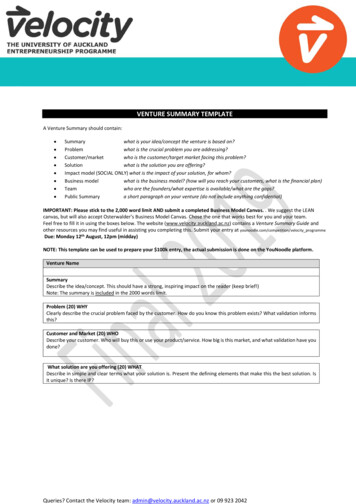
Transcription
Seventh Northwest Conservation and Electric Power PlanCHAPTER 1:EXECUTIVE SUMMARYThe Pacific Northwest power system faces a host of uncertainties, from compliance with federalcarbon dioxide emissions regulations to future fuel prices, resource retirements, salmon recoveryactions, economic growth, a growing need to meet peak demand, and how increasing renewableresources would affect the power system. The Council’s Seventh Power Plan addresses theseuncertainties and provides guidance on which resources can help ensure a reliable and economicalregional power system over the next 20 years.In developing its plan, the Council relies on feedback from technical and policy advisory groups andinput from a broad range of interests, including utilities, state energy offices, and public interestgroups.The plan also recognizes that individual utilities, which have varying access to electricity marketsand varying resource needs, may require near-term investments in resources to meet theiradequacy and reliability needs. For example, some utilities face significant near-term resourcechallenges, particularly if there is limited access to surplus resources from others. These factors limitthe ability of the regional resource strategy to be specific about optioning and construction dates fornatural gas-fired resources, or for the types of natural gas-fired generation. As a result, new gasfired generation may be required in such instances, even if utilities deploy demand responseresources and develop the energy efficiency called for in the plan.Using modeling to test how well different resources would perform under a wide range of futureconditions, energy efficiency consistently proved the least expensive and least economically riskyresource. In more than 90 percent of future conditions, cost-effective efficiency met all electricityload growth through 2035. It’s not only the single largest contributor to meeting the region’s futureelectricity needs, it’s also the single largest source of new winter peaking capacity. If developedaggressively, in combination with past efficiency acquisition, the energy efficiency resource couldapproach the size of the region’s hydroelectric system’s firm energy output, adding to theNorthwest’s heritage of clean and affordable power. Figure 1 - 1 shows the composition of theSeventh Plan’s Resource Portfolio.nwcouncil.org/7thplan1-1
Chapter 1: Executive SummaryFigure 1 - 1: Seventh Plan Resource Portfolio1Resource Development (Average Megawatts)6,0005,000Natural GasSolar4,000WindEnergy ring this energy efficiency is the primary action for the next six years. The plan’s second priorityis to develop the capability to deploy demand response resources or rely on increased marketimports to meet system capacity needs under critical water and weather conditions. While theregion’s hydroelectric system has long provided ample peaking capacity, it’s likely that under lowwater and extreme weather conditions we’ll need additional winter peaking capacity to maintainsystem adequacy. Because the probability of such events is low (but real), demand responseresources, which have low development and “holding” costs are best-suited to meet this need.However, whether and to what extent the region should rely on demand response or increase itsreliance on power imports to meet regional resource adequacy requirements for winter capacitydepends on their comparative availability, reliability, and cost.After energy efficiency and demand response, new natural gas-fired generation is the most costeffective resource option for the region in the near-term. Similarly, after energy efficiency, theincreased use of existing natural gas generation offers the lowest cost option for reducing regionalcarbon emissions. Combined with investments in renewable generation, as required by staterenewable portfolio standards, improved efficiency, demand response resources, and natural gasgeneration are the principal components of the plan’s resource portfolio.Figure 1 - 1 shows the average resource development across all 800 futures tested in the Regional Portfolio Model.Actual development, particularly of non-energy efficiency resources, will depend on actual future conditions.1nwcouncil.org/7thplan1-2
Chapter 1: Executive SummaryA key question for the plan was how the region could lower power system carbon dioxide emissionsand at what costs. The Council’s modeling found that without additional carbon control policies,carbon dioxide emissions from the Northwest power system are forecast to decrease from about 55million metric tons in 2015 to around 34 million metric tons in 2035, 2 the result of retiring theCentralia, Boardman, and North Valmy coal plants by 2026; using existing natural gas-firedgeneration to replace them; and developing about 4,500 average megawatts of energy efficiency by2035, which should meet all forecast load growth over that time frame.In these circumstances, the region, as a whole, will be able to comply with the EnvironmentalProtection Agency’s carbon emissions limits, even under critical water conditions.The Council also assessed alternative policies to further reduce emissions. With today’s technology,carbon dioxide emissions could be reduced to about 12 MMTE, almost 80 percent below 2015emissions (under average water conditions). This would require retiring all the coal generationserving the region, which is responsible for more than 85 percent of system emissions; retiring themost inefficient natural gas-fired generation; and acquiring additional energy efficiency and demandresponse resources. The estimated cost of doing this is nearly 20 billion over the cost of otherresource portfolios that comply with federal carbon dioxide emissions limits at the regional level.Reducing the region’s power system carbon footprint below that level isn’t technically feasiblewithout developing new technologies.Figure 1 - 2 shows the forecast average carbon dioxide emissions in 2035 under the variousscenarios tested in developing the plan.This is the level of carbon dioxide emissions estimated to be generated to serve regional load under average water andweather conditions. Actual 2015 carbon dioxide emissions could differ significantly from this level based on actual waterand weather conditions. Average regional carbon dioxide emissions from 2001–2012 were 55 MMTE, but ranged from 43MMTE to 60 MMTE.2nwcouncil.org/7thplan1-3
Chapter 1: Executive SummaryFigure 1 - 2: Forecast Northwest Power System Carbon Dioxide Emissions in 2035 by ScenarioAverage CO2 Emissions 2000-2012No Coal Retirements*Existing PolicyRenewable Portfolio Standard @ 35%Carbon Cost RiskSocial Cost of Carbon - Mid-RangeSocial Cost of Carbon - HighMaximum Carbon Reduction - Existing TechnologyMaximum Carbon Reduction - Emerging Technology-204060Carbon Dioxide Emissions in 2035 (MMTE)* Scenario assumed that the announced retirements of Boardman, Centralia and North Valmy coalplants do not occur.Investments to add transmission capability and improve operational agreements are important forthe region, both to access growing site-based renewable energy and to better integrate low andzero-emission resources into the existing power system. The Council also expects that there aresmall-scale resources available at the local level in the form of cogeneration or renewable energyopportunities. The plan encourages investment in these resources when cost-effective.The plan encourages research in advanced technologies to improve the efficiency and reliability ofthe power system. For example, emerging smart-grid technologies could make it possible forconsumers to help balance supply and demand. Providing information and tools to consumers toadjust electricity use in response to available supplies and costs would enhance the capacity andflexibility of the power system. Smart-grid development could also help integrate electric vehicleswith the power system to aid in balancing the system and reduce carbon emissions in thetransportation sector. Research on how distributed solar generation with on-site storage might affectsystem load shape is also encouraged.Other resources with potential, given advances in technology, include geothermal, ocean waves,advanced small modular nuclear reactors, and emerging energy efficiency technologies. Newmethods to store electric power, such as pumped storage or advanced battery technologies mayenhance the value of existing variable generation like wind.nwcouncil.org/7thplan1-4
Chapter 1: Executive SummaryDeveloping these technologies is a long-term process that will require many years to reach fullpotential. The region can make progress through investments in research, development, anddemonstration projects.FUTURE REGIONAL ELECTRICITY NEEDS ANDPRICESPacific Northwest regional loads, measured at the generation site, are expected to increase bybetween 2,200 and 4,800 average megawatts between 2015 and 2035. This translates to anaverage increase of between 110-240 average megawatts per year, or a growth rate of between 0.51.0 percent per year. The regional peak load for power, which typically occurs in winter, is forecastto grow from about 30,000 - 31,000 megawatts in 2015 to around 32,000 - 36,000 megawatts by2035. This equates to an average annual growth rate of between 0.4 - 0.8 percent.Residential and commercial sectors account for much of the growth in demand. Contributing to thisgrowth is increasing air conditioning load, new data centers, and growth in indoor agriculture. Also,summer peak electricity use is expected to grow more rapidly than annual energy demand. All of thisgrowth in demand must be met by a combination of existing resources, energy efficiency, and newgeneration.An important finding of the plan is that future electricity needs can no longer be adequatelyaddressed by only evaluating average annual energy requirements. Planning for capacity to meetpeak load and flexibility to provide within-hour, load-following, and regulation services will also needto be considered.Requirements for within-hour flexibility reserves have increased because of the growing amount ofvariable wind generation in the region. While the plan doesn’t foresee renewable resourcedevelopment beyond what is required to satisfy existing state renewable portfolio standards,improved regional coordination could reduce the need for resources used to integrate existingrenewables. For example, establishing energy imbalance markets could enable sharing resourcesreserved for integrating wind resources.Wholesale electricity prices at the Mid-Columbia hub remain relatively low, reflecting the abundanceof low-variable cost generation from hydro and wind, as well as continued low natural gas prices.The average wholesale electricity price in 2014 was 32.50 per megawatt-hour. By 2035, prices areforecast to range from 33 to 60 per megawatt-hour in 2012 dollars. The upper and lower boundsfor the forecast wholesale electricity price were set by the associated high and low natural gas priceforecast. Although the dominant generating resource in the region is hydropower, natural gas-firedplants are often the marginal generating unit for any given hour. Therefore, natural gas prices exerta strong influence on the wholesale electricity price, making the natural gas price forecast a keyinput. The region depends on externally sourced gas supplies from Western Canada and the U.S.Rockies.Prices for natural gas have dropped significantly since reaching a high in 2008, and they’re expectedto remain relatively low going forward. Historically, natural gas prices have been volatile, so the planuses a range of forecasts to capture most potential futures. The low price forecast range starts atnwcouncil.org/7thplan1-5
Chapter 1: Executive Summary 3.50 per MMBtu in 2015 and declines in real dollars to 3.00 per MMBtu by 2035. This low-rangecase represents a future with slow economic growth, low gas demand, and robust supplies. The highprice forecast range climbs to 10 per MMBtu by 2035. This forecast represents a future with higheconomic growth, high demand for natural gas, and a limited gas supply.Recent promulgation of federal regulations that limit carbon emissions from both new and existingpower generation are expected to increase the demand for natural gas. These higher natural gasprices result in higher wholesale electricity prices. Therefore, some of the futures used to developthis plan include a wide range of possible natural gas and electricity prices. Additional carbonregulations or costs could further increase electricity costs for consumers. While higher pricesreduce demand, they also stimulate new sources of supply and efficiency and make more efficiencymeasures cost-effective.RESOURCE STRATEGYThe plan’s resource strategy provides guidance to the Bonneville Power Administration and regionalutilities on resource development to minimize the costs and risks of the future power system. Timingof specific resource acquisitions will vary for each utility.Energy Efficiency: The region should aggressively develop energy efficiency with a goal ofacquiring 1,400 average megawatts by 2021; 3,100 average megawatts by 2026; and 4,500 averagemegawatts by 2035. Efficiency is by far the least expensive resource available to the region,avoiding the risks of volatile fuel prices and large-scale resource development, while mitigating therisk of potential carbon pricing policies. Along with its annual energy savings, it helps meet futurecapacity needs by reducing both winter and summer peak demand.Demand Response: In order to satisfy regional resource adequacy standards, the region should beprepared to develop significant demand response resources by 2021 to meet additional winterpeaking capacity. The least-cost solution for providing new peaking capacity is to develop costeffective demand-response resources, the voluntary and temporary reduction in consumers’ use ofelectricity when the power system is stressed. The Northwest’s power system has historically reliedon the hydrosystem to provide peaking capacity, but under critical water and weather conditionswe’ll need additional capacity to meet the region’s adequacy standard.Renewable Resources: Modest development of renewable generation will meet existingrenewable portfolio standards. On average, renewable resources developed to fulfill state RPSmandates will contribute about 300 average megawatts of energy, or around 900 megawatts ofinstalled capacity. While wind generation has been the dominant renewable resource developed inthe region, lower costs for solar photovoltaic technology are expected to make it more competitive.As a result, compliance is expected to be met through both wind and solar PV systems. Howeverthese renewable resources lack dependable winter peak capacity and also require within-hourbalancing reserves. Therefore, the Seventh Plan’s resource strategy encourages research anddemonstration of other potential renewable resources, such as geothermal and wave energy, whichhave more consistent output. The resource strategy also encourages developing other renewablealternatives that may be available at the local, small-scale level and are cost-effective now.nwcouncil.org/7thplan1-6
Chapter 1: Executive SummaryNatural Gas: Increased use of existing natural gas generation is expected to replace retiring coalplants and meet carbon-reduction goals in the near term. Only low to modest amounts of newnatural gas-fired generation is likely to be needed to supplement energy efficiency, demandresponse, and renewable resources, unless the region experiences prolonged periods of high loadgrowth. Even if the region has adequate resources, individual utilities or areas may need additionalsupply for energy, capacity or wind integration. In these instances, the strategy relies on natural gasfired generation to provide energy, capacity, and ancillary services.Regional Resource Use: Continue to improve system scheduling and operating procedures acrossthe region’s balancing authorities. These cost-effective steps will help minimize reserves needed tointegrate renewable resources. The region also needs to invest in its transmission grid to improvemarket access for utilities, reduce line losses, and help develop diverse cost-effective renewablegeneration. Finally, the least-cost resource strategies rely first on regional resources to satisfy theregion’s resource adequacy standards. Under many futures conditions, these strategies reduceregional exports.Carbon Policies: To ensure that future carbon policies are cost-effective and maintain regionalpower system adequacy, the region should develop the energy efficiency resources called for in theplan and replace retiring coal plants with only those resources needed to meet regional capacity andenergy adequacy requirements. As stated earlier, after energy efficiency, increasing use of existingnatural gas generation offers the lowest cost option for reducing regional carbon emissions.Developing new gas-fired generation to meet local needs for ancillary services, such as windintegration, or capacity requirements beyond the modest levels anticipated in the plan will increasecarbon dioxide emissions. If Northwest electricity generation is dispatched first to meet regionaladequacy standards for energy and capacity rather than to serve external markets, carbon dioxideemissions can be minimized.Future Resources: In the long term, the Council encourages the region to expand its resourcealternatives. The region should explore other sources of renewable energy, especially technologiesthat provide both energy and winter capacity; new efficiency technologies; new energy-storagetechniques; smart-grid technologies and demand-response resources; and new or advanced lowcarbon generating technologies, including advanced nuclear energy. Research, development, anddemonstration funding should be prioritized in areas where the Northwest has a comparativeadvantage or where unique opportunities emerge.Adaptive Management: The Council will annually assess the adequacy of the regional powersystem to guard against power shortages. Through this process, the Council will be able to identifywhen conditions differ significantly from planning assumptions so the region can respondappropriately. The Council will also conduct a mid-term assessment to review the plan’simplementation and ensure the successful implementation of the Council’s Columbia River BasinFish and Wildlife Program.Energy EfficiencyThe dominant new resource in the Seventh Power Plan’s resource strategy is improved energyefficiency. Figure 1 - 3 shows that under scenarios that consider carbon risk and those that do not,and even when natural gas and wholesale electricity prices are lower than expected, the region’s netnwcouncil.org/7thplan1-7
Chapter 1: Executive Summaryload after developing all cost-effective efficiency is basically the same over the next 20 years. Inmore than 90 percent of the 800 futures evaluated by the Council, across more than 20 differentscenarios, the least cost resource strategy developed sufficient energy efficiency resource to meetall regional load growth through 2035. Indeed, even in the scenario (Lower Energy Efficiency) thatassumed only energy efficiency costing less than short-term wholesale market prices would beacquired, all regional load growth through 2030 was met with energy efficiency. However, it shouldbe noted that developing this lower level of efficiency increased regional power system cost by 14billion or 16 percent higher compared to resource strategies that developed sufficient energyefficiency to meet all load growth through 2035 .This is because improved efficiency is relatively cheap, it provides both energy and capacitysavings, and it has no major risks. It’s half what other resources cost, without the risk of volatile fuelprices or costs of carbon reduction policies. It also has a short lead time and is available in smallincrements, both of which reduce risk. Therefore, improved efficiency reduces the cost of, and risksto, the power system.Figure 1 - 3: Average Net Regional Load After Accounting for Cost-Effective EnergyEfficiency Resource DevelopmentNorthwest Annual Load After Energy Efficiency(Average Megawatts)25,00020,00015,00010,000Existing PolicySocial Cost of Carbon - HighLow Gas Prices5,000Lower Energy Efficiency20152020202520302035Figure 1 - 4 compares the average cost of the energy efficiency resources and the cost ofgenerating resources considered in the plan’s development. Two estimates of the cost of energyefficiency are shown. The lower average cost ( 18 per megawatt-hour) reflects energy efficiency’simpact on the need to expand distribution and transmission systems. The higher cost ( 30 permegawatt-hour) does not include these power system benefits.nwcouncil.org/7thplan1-8
Chapter 1: Executive SummaryThe comparable estimated cost of a natural gas-fired combined-cycle combustion turbine is around 75 per megawatt-hour. The current cost of utility-scale solar photovoltaic systems is approximately 100 per megawatt-hour and Columbia Basin wind costs 110 per megawatt-hour. Over time, thecost of utility-scale solar photovoltaic systems is forecast to drop to around 65 per megawatt-hour.Significant amounts of improved efficiency also cost less than the forecast market price of electricity,since nearly 2,300 average megawatts energy efficiency savings are available below the averagecost of 30 per megawatt-hour.In the Council’s analysis, additional resources provide insurance against an uncertain future.Efficiency improvements are particularly attractive as insurance because of their low cost andmodular size. When the resources aren’t needed, the energy savings from low cost energy efficiencyresources can be sold in the market, paying for itself and then some.In all of the scenarios and sensitivity studies examined by the Council, similar amounts of improvedefficiency are found to be cost-effective even without carbon costs. If carbon reduction policies areenacted, efficiency improvements can help the region meet those goals. In all scenarios tested bythe Council, the amount of cost-effective efficiency developed averaged between 1,300 and 1,450average megawatts by 2021 and between 3,900 and 4,600 average megawatts by 2035.Figure 1 - 4: Energy Efficiency and Generating Resource Cost ComparisonEnergy Efficiency (Average Cost w/ T&D Credit)Energy Efficiency (Average Cost w/o T&D Credit)Solar PV - Low CostNatural Gas - CCCTSolar PV - Base CostWind - MT w/ New transmissionWind - MT w/ Transmission UpgradeWind - Columbia BasinNatural Gas - FrameSolar PV- w/ Transmission ExpansionNatural Gas - Reciprocating EngineNatural Gas - Aero - 20 40 60 80 100 120 140 160Real Levelized Cost (2012 /MWh)CapitalO&M Property Taxes Insurancenwcouncil.org/7thplanFuel Transmission1-9
Chapter 1: Executive SummaryDemand ResponseDemand response resources are voluntary reductions in customer electricity use during periods ofhigh demand and limited resource availability. The plan’s resource strategy uses demand responseto meet winter and summer peak demands, primarily under critical water and extreme weatherconditions. The strategy doesn’t consider other possible applications of demand response--tointegrate variable resources like wind for example.The Council’s assessment identified more than 4,300 megawatts of regional demand responsepotential. A significant amount of this potential, nearly 1,500 megawatts, is available at relatively lowcost; less than 25 per kilowatt of peak capacity per year. When compared to the alternative ofconstructing a simple cycle gas-fired turbine, demand response can be deployed sooner, inquantities better matched to the peak capacity need, deferring the need for transmission upgradesor expansions.In particular, demand response is the least expensive means to maintain peak reserves for systemadequacy. Its low cost is especially valuable because the need for peaking capacity in the regionlargely depends on water and weather conditions. Under most scenarios, there was about a 20percent probability that as much as 600 megawatts of demand response would be cost-effective todevelop by 2021, and a 15 percent probability that as much as 1,100 megawatts would be costeffective to develop by 2026.Alternatively, the region could rely on external power markets to meet its winter peak capacityneeds. In one scenario tested by the Council, the region relied more on external markets (Canada,California, and the Southwest) which greatly reduced the need to develop demand response. Thatscenario relaxed the Council’s current assumptions about the availability of imports from out-ofregion sources and from in-region market resources. Since that scenario’s system cost andeconomic risk were lower than scenarios in which cost-effective demand response was acquired, theplan’s resource strategy recommends that the Council’s Resource Adequacy Advisory Committeereexamine all potential sources of imported energy and capacity to minimize cost and avoid the riskof overbuilding. 3Generation ResourcesThe Council analyzed a large number of alternative generating technologies. Each was evaluated interms of risk characteristics, cost, and potential for improvements in its efficiency over time. Inaddition, resources were considered in terms of their energy, capacity, and flexibility characteristics,such as their ability to ramp up and down to accommodate variations in the output of wind and solarPV resources.In the near term, generating technology options that are technologically mature, meet the emissionrequirements for new plants, and are cost-effective are limited in number. Improvements in the3See Council Action Item 10.nwcouncil.org/7thplan1-10
Chapter 1: Executive Summaryefficiency and operation of natural gas-fired generation make it the most cost-effective option fornow. While wind continues to be the primary large-scale, cost-effective renewable resource,decreasing costs for utility-scale and distributed-scale photovoltaic systems have made them costcompetitive sources of energy supply.Other resource alternatives may become available over time, and the plan recommends actions toencourage their development, especially those that don’t produce greenhouse gas emissions.Since the adoption of the Sixth Power Plan, renewable resource development in the Northwest hasincreased significantly, particularly wind. By the end of 2014, wind capacity in the region totaled justmore than 8,700 megawatts. However, only about 5,550 megawatts of that capacity currently servesNorthwest loads. The remaining 3,150 megawatts of wind capacity is presently contracted to utilitiesoutside the region, primarily California. Wind now constitutes about 8 percent of the region’selectricity supply, although expiring incentives and low load growth are expected to slowdevelopment over the next five years.Current wind generation is estimated to provide about 2,400 average megawatts per year in theregion. Wind resources with access to transmission are cost competitive with other generation.However, given current technology, wind can reliably provide about 5 percent of its nameplatecapacity to meet peak loads. On a firm capacity basis, wind provides about 1 percent of the totalsystem peaking capability.The amount of additional renewable energy acquired on average in the least-cost resourcestrategies across scenarios didn’t vary significantly, even in scenarios with high carbon cost risk.This is because the two economically competitive renewable resources available in the region, windand solar PV, provide little or no winter peaking capacity. Partly because of the significant winddevelopment in the region over the past decade, the Northwest has a significant energy surplus, yetunder critical water conditions the region faces the probability of a peak capacity shortfall–again,because wind provides little winter capacity.Renewable generation development in the plan is driven by state renewable portfolio standards. Inthe absence of higher standards, little additional renewable development is needed, even underscenarios where the highest social cost of carbon was assumed. The Council recognizes thatadditional small-scale renewable resources are available and cost-effective, and the planencourages their development as an important element of the resource strategy. For example,Snohomish PUD recently completed the Youngs Creek hydroelectric project and Surprise ValleyElectric Cooperative is developing the Paisley Geothermal Project, a low-temp geothermal powerproject in rural Oregon. There are many other potential renewable resources that may, withadditional research and demonstration, prove to be cost-effective and valuable for the region todevelop.Natural gas is the fourth major element in the plan’s resource strategy. It’s clear that after efficiencyand demand response, new natural gas-fired generation is the most cost-effective resource optionfor the region in the near term. After energy efficiency, increased use of existing natural gasgeneration is the lowest cost option to reduce regional carbon dioxide emissions. It plays a majorrole in the least-cost resource strategies to reduce carbon dioxide emissions. Existing natural gasgeneration increases immediately in scenarios where carbon costs are imposed.nwcouncil.org/7thplan1-11
Chapter 1: Executive SummaryAcross the scenarios evaluated, the optioning and completion of new gas-fired generating resourcesvaried widely. New gas-fired plants are optioned (sited and licensed) so that they are available todevelop if needed in each future. The plan’s resource strategy includes optioning new gas-firedgeneration as local needs dictate. However, from an aggregate regional perspective, which is theplan’s focus, the need for additional new natural gas-fi
EXECUTIVE SUMMARY . The Pacific Northwest power system facesa host of uncertainties, from compliance with federal carbon dioxide emissions regulations to future fuel prices, resource retirements, salmon recovery actions, economic growth, a growing need to meet peak demand, and how increasing renewable










